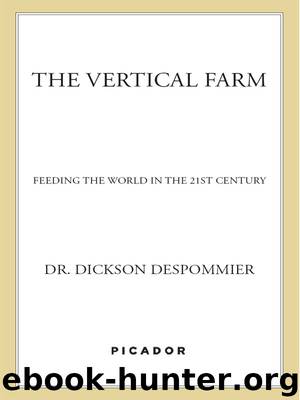The Vertical Farm by Dr. Dickson Despommier

Author:Dr. Dickson Despommier
Language: eng
Format: epub
Publisher: St. Martin's Press
Published: 2011-09-09T04:00:00+00:00
4. Allowance for Ecosystem Restoration
If a significant amount of farming were to take place inside the urban landscape, then the world’s ecological footprint of agriculture would become smaller. For most crops, about ten to twenty times the acreage it takes to raise them indoors could be converted back into hardwood forest outside. This is because crops can be grown year-round and none would be lost due to severe weather events. Large-scale environmental restoration is high on everyone’s list of things we wish we could do, but most perceive it as an unrealistic goal due to the amount of land we now need to farm, with more land needed in the near future as the human population continues to increase. The Food and Agriculture Organization laments in each edition of its State of Food Insecurity in the World reports that the simple solution to restoring the natural world is to leave it alone. One could seriously question this strategy of benign neglect, since the great majority of us now live either in cites or their suburbs and have never had the occasion to witness nature in a restorative mode. But be assured that there are numerous “proofs of concept” out there that convincingly demonstrate that the environment is much more resilient than we give it credit for. The dust bowl of the American Midwest returned to tall- and short-grass prairie just 20 years after most experts in land management had written it off as a desolate, sterile region never to recover. It’s no wonder they held this pessimistic view, when newsreel footage of that period shows toxic black clouds of topsoil about to engulf a whole town. Nonetheless, in the absence of any outside influence (i.e., farming), save for a few small restoration efforts on the part of the government, it quietly returned to its former ecological setting.
The entire northeastern portion of the United States was clear-cut at least three times in our history, and when it became apparent each time that farming could not succeed there, the land was abandoned and the trees obliged by returning in full force. An excellent example that has a solid scientific basis for describing what happens to a forest when it’s been clear-cut, then left alone, can be found in the online records of the Hubbard Brook Ecosystem Study (http://www.hubbardbrook.org/), whose ecological setting is in northern New Hampshire. A summary of the study’s initial results is instructive to those who remain skeptical that nature has the resources to recover from a catastrophic event like being clear-cut. When the study was initiated in 1967, an entire watershed’s worth of forest was cut down, but the trees were left in place. The quality of the water draining the watershed was continuously monitored for dissolved minerals and organic compounds before, during, and after clear-cutting. Three years later, the quality of the water in the streams had returned to preexperimental condition. The trees took longer to grow back. At first, pioneer plants—shrubs and bushes—dominated the landscape. These were
Download
This site does not store any files on its server. We only index and link to content provided by other sites. Please contact the content providers to delete copyright contents if any and email us, we'll remove relevant links or contents immediately.
| Automotive | Engineering |
| Transportation |
Whiskies Galore by Ian Buxton(41519)
Introduction to Aircraft Design (Cambridge Aerospace Series) by John P. Fielding(32880)
Small Unmanned Fixed-wing Aircraft Design by Andrew J. Keane Andras Sobester James P. Scanlan & András Sóbester & James P. Scanlan(32565)
Craft Beer for the Homebrewer by Michael Agnew(17921)
Turbulence by E. J. Noyes(7688)
The Complete Stick Figure Physics Tutorials by Allen Sarah(7133)
Kaplan MCAT General Chemistry Review by Kaplan(6581)
The Thirst by Nesbo Jo(6429)
Bad Blood by John Carreyrou(6266)
Modelling of Convective Heat and Mass Transfer in Rotating Flows by Igor V. Shevchuk(6217)
Learning SQL by Alan Beaulieu(6022)
Weapons of Math Destruction by Cathy O'Neil(5815)
Man-made Catastrophes and Risk Information Concealment by Dmitry Chernov & Didier Sornette(5636)
Digital Minimalism by Cal Newport;(5369)
Life 3.0: Being Human in the Age of Artificial Intelligence by Tegmark Max(5174)
iGen by Jean M. Twenge(5148)
Secrets of Antigravity Propulsion: Tesla, UFOs, and Classified Aerospace Technology by Ph.D. Paul A. Laviolette(4970)
Design of Trajectory Optimization Approach for Space Maneuver Vehicle Skip Entry Problems by Runqi Chai & Al Savvaris & Antonios Tsourdos & Senchun Chai(4836)
Electronic Devices & Circuits by Jacob Millman & Christos C. Halkias(4737)
